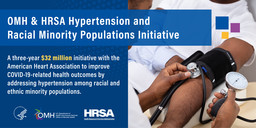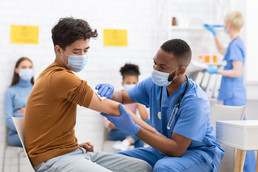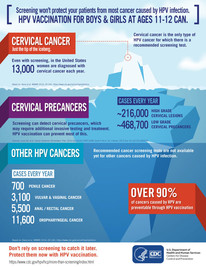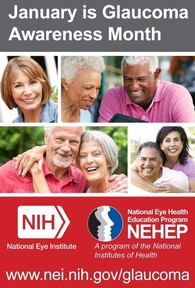 Often times the start of a New Year means focusing on your health and wellbeing as part of your new year's resolution. The HHS Office of Minority Health (OMH) encourages everyone to make 2021 their healthiest year yet by staying active and healthy! According to the Centers for Disease Control and Prevention (CDC), six in ten adults in the U.S. have a chronic disease and four in ten adults have two or more. Major chronic diseases such as heart disease, cancer and diabetes are the leading causes of death in America, especially among racial and ethnic minority populations. By making healthy choices, you can reduce your likelihood of getting a chronic disease and improve your quality of life. Follow these tips recommended by the CDC to boost your health and well-being all year long. |  Last month, OMH and the Health Resources and Services Administration (HRSA) Bureau of Primary Health Care announced a three-year $32 million initiative with the American Health Association to improve COVID-19-related health outcomes by addressing hypertension among racial and ethnic minority populations. According to the 2020 Surgeon General's Call to Action to Control Hypertension, "high blood pressure continues to be a leading risk factor for heart disease; furthermore, social determinants of health, such as inequalities in the distribution of social, economic, and environmental conditions needed for health, have been associated with hypertension risk among non-Hispanic blacks and other minority groups." The initiative will integrate remote blood pressure monitoring technology into the treatment of hypertension for patients served by participating HRSA-funded health centers and support the American Heart Association's targeted media campaigns to help reach Black, Latino, and other impacted communities with culturally and linguistically appropriate messages. |  With the recent launch of authorized and recommended vaccines to prevent COVID-19 in the U.S., OMH is focusing its efforts on raising awareness about the importance of getting the COVID-19 vaccine, establishing vaccine confidence, and combatting vaccine hesitancy, especially among racial and ethnic minority groups. As racial and ethnic minorities continue to feel a disproportionate impact of COVID-19, community and faith-based organizations, employers, healthcare systems and providers, public health agencies, policymakers, and others can all play a part in helping to promote fair access to health. To help prepare communities for the vaccine, CDC released 8 Things to Know about the U.S. COVID-19 Vaccination Program and information to prepare healthcare workers for the distribution of the vaccine. Healthcare providers can find information about vaccine planning, guidance on how to talk to patients, and the benefits of getting a COVID-19 vaccine by visiting cdc.gov/coronavirus. |  Every year, more than 13,000 women are diagnosed with cervical cancer in the U.S., and more than 4,200 die as a result. According to the CDC, persistent infection with high-risk types of human papillomavirus (HPV) is the leading cause of cervical cancer. Black and Hispanic women suffer from higher rates of HPV-associated cervical cancer than women of other races. To prevent cervical cancer, there are simple steps you can take, such as getting vaccinated early and getting screened regularly. It is recommended that girls and boys get the HPV vaccine at age 11-12 to produce a stronger immune response, but women and men can be vaccinated through age 45. Women should also start regular Pap screenings at age 21. To see if you qualify for a free or low-cost screening or to find a program near you, visit CDC's website. |  Did you know that feeling you best includes seeing your best? This Glaucoma Awareness Month learn about the disease and how to keep your eyes healthy. According to the National Institutes of Health (NIH): National Eye Institute, glaucoma can cause vision loss and blindness, which can't be reversed. In the U.S., half the people who have glaucoma don't know they have it. As a result, African Americans over 40, adults over 60 – especially Hispanics/Latinos, and people with a family history of the disease are at higher risk, making early detection especially important. Glaucoma often has no early warning signs or symptoms that is why it is important to visit your eye doctor and get a comprehensive dilated eye exam to catch the disease early and start treatment. Visit the National Eye Institute Glaucoma Awareness Month webpage to learn more and downloadable materials to help spread the word. |  Healthy Weight Week is celebrated from January 19-25 and during this week, Americans are encouraged to get moving, especially after the holidays, to improve their health. According to the National Heart, Lung, and Blood Institute (NHLBI), maintaining a healthy weight can help prevent and control many diseases such as heart disease, high blood pressure, diabetes, and certain cancers. It helps lower your risk of these diseases, helps you feel good about yourself, and gives you more energy. Participating in Healthy Weight Week doesn't have to be difficult or time consuming. Get motivated to stay active and eat healthy with tips from the Office of Disease Prevention and Health Promotion and the NIH National Institute on Aging. Visit their website for more information, downloadable materials and resources. |  Cervical cancer awareness and prevention are important factors for minority women. The OMH Knowledge Center online catalog provides a targeted list of articles that explain how programs that address attitudes and beliefs toward screening and preventive behaviors can improve minority women's health. To read these publications, search the online library catalog here. | |

No comments:
Post a Comment